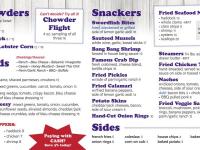National Canned Food Month recipes
February has a couple of holidays that have are loosely associated with food. Today is Valentine's Day (chocolate anyone?) And Happy V-Day to you, dear Peter, and there’s usually a cherry pie on the menu for good old George’s birthday on February 22, but there’s another “holiday” we should celebrate this month and that leads me to the topic du jour: February is National Canned Food Month.
We must tip our toques to French pastry chef Nicholas Appert who spent much of the 1790s experimenting with preserving fruits, vegetables and meat by heating the food product and then preserving it in glass bottles, just like wine.
In 1803 he sent samples of his food to the French Navy for trials at sea and received much acclaim. The government of France persuaded him (via 12,000 francs) to disclose an accounting of his work in preserving food. This information was published in 1810 and was immediately translated and re-published in Sweden, England, German and America and many manufacturing operations were set up according to his standards.
Unbreakable tin-plated iron cans soon replaced the fragile glass containers, a method perfected by Bryan Dorkin and John Hall. These 2 gents set up the first commercial canning factory in England in 1813.
As demand for canned goods grew, Englishman Thomas Kensett emigrated to the USA and established the first canning facility in New York in 1812. Oysters, meats, fruits and vegetables were successfully canned and grew in popularity.
The canning process of today’s world is not dramatically different from that of Chef Appert. Food is heated to temperature that sufficiently destroys microorganisms and is then packed into sealed containers (we now use 100 percent recyclable steel), heated under steam pressure at temperatures of 240-250°F and that’s it!
Once the cans are sealed and heat processed, the food will maintain its high quality for two or more years so long as the container is not damaged in any way.
I remember an answer on the television show “Jeopardy” many years ago which was: “This is the only vegetable that is not preserved by canning” and the correct question was: “What is lettuce?”
I have no idea why I remember that when I don’t even remember what I had for breakfast this morning.
Virtually any food grown or processed can be found in your supermarket’s canned food aisle. Granted we consumers have many alternatives (fresh and frozen) to canned food, but the good old “tin can” remains an essential part of the modern pantry.
All of this week’s recipes contain canned ingredients in honor of National Canned Food Month.
Margaritas for a crowd
- 1 can (12-oz.) frozen limeade
- 12 oz. water
- 12 oz. tequila
- 6 oz. orange flavored liqueur (I use Triple Sec)
- 2 limes (grate the zest from 1 lime and set aside for the glass rim coating)
Place frozen limeade in a blender. Refill the can with water; add to blender. Refill can with tequila; add to blender. Fill the can 1/2 full with orange liqueur; and add to blender. Squeeze the juice of two fresh limes into the blender. Cover blender and process until combined.
Rub the rims of margarita glasses with fresh lime and then dip into a mixture of 3 parts salt to 1 part sugar and the finely grated zest of 1 lime. Add ice cubes to glass and fill with margarita mixture.
Chicken, black bean and corn quesadillas
- 3 cups shredded cooked chicken (shortcut: deli rotisserie chicken)
- 3 cups shredded Monterey Jack cheese with jalapenos
- 1 CAN (15-oz.) black beans, drained and rinsed
- 1 CAN (15-oz.) corn, drained
- 4 oz. cream cheese, softened and cut into small pieces
- 1/2 cup chunky salsa, warmed*
- 2 Tbsp. minced fresh cilantro
- 2 tsp. ground ancho chile pepper
- 1/2 tsp. salt
- 8 burrito-size flour tortillas
- 1/4 cup vegetable oil
Suggested toppings: guacamole, sour cream, chopped tomatoes, shredded lettuce, green onions
Combine chicken, cheese, beans, corn, cream cheese, salsa, cilantro, chile pepper, and salt. Spoon about 1/2 cup mixture on half of each tortilla. Fold in half, pressing gently to seal. Lightly brush both sides of quesadillas with oil and place in a large non-stick skillet set over medium heat. Cook quesadillas 3-4 minutes per side or until golden brown on outside and cheese is melted. Cut into wedges and serve with toppings. Yield: 4-6 servings.
*Warming the salsa helps melt the cream cheese a bit making it easier to mix the ingredients evenly.
Haddock with tomatoes, olives and capers
- 4 tsp. olive oil, divided use
- 4 (5-oz. each) haddock fillets
- 1 small onion, peeled and diced
- 1/2 cup white wine
- 1 cup CANNED diced tomatoes with juice
- 1/2 cup CANNED chopped pitted black olives
- 2 Tbsp. capers, drained and rinsed
- 1/4 tsp. dried crushed red pepper flakes
- 2 cups packed fresh baby spinach
- Salt and freshly ground black pepper to taste
Heat 2 teaspoons of oil in a large non-stick skillet set over medium-high heat. Add fish and cook 2-3 minutes per side or until cooked through. Transfer the fish to a platter and tent with foil. Heat the remaining 2 teaspoons of oil in the same skillet; add onion and sauté for 2 minutes.
Add the wine and cook for 2 minutes or until reduced by half. Add the tomatoes with their juices, olives, capers and crushed red pepper; cook for 3 minutes more. Stir in spinach and cook until 3 minutes or until wilted. Season to taste with salt and black pepper. Spoon the sauce over the fish and serve immediately. Yield: 4 servings
Oatmeal Carmelita bars
- 2 cups all purpose flour
- 1 tsp. baking soda
- 1/4 tsp. salt
- 2 sticks (1 cup) unsalted butter, softened
- 1-1/2 cups light brown sugar
- 2 cups quick-cooking oatmeal
- 14 oz caramel candies, unwrapped
- 1/2 cup CANNED evaporated milk
- 1 cup semisweet chocolate chips
- 1 cup chopped pecans
Combine flour, baking soda and salt; set aside.
Place butter and brown sugar in a large bowl and beat until creamy for 3 minutes on medium speed of electric mixer. Reduce speed to and slowly add the flour mixture until fully incorporated. Add the oatmeal and mix on low just until combined.
Transfer approximately half of the dough mixture to a 13x9x2-inch baking dish coated with non-stick spray. Spread and press the dough into the dish until you have an even layer with no cracks. Bake in a preheated 350°F oven for 10 minutes; remove from oven.
While the dough is baking, combine evaporated milk and caramels in a small saucepan set over medium-low heat. Cook, stirring constantly, until caramels are melted and mixture is thick. Remove pan from heat and cool until you remove baking dish from the oven.
Once out of the oven, sprinkle cookie base evenly with chocolate chips and pecans; carefully pour the warm caramel sauce over the top and spread into an even layer. Sprinkle remaining cookie dough evenly over the top of the caramel-chocolate-nut mixture. Return pan to the oven and bake for 12-15 minutes or until topping is lightly browned. Let cool before cutting. Yield: 24 bars
Paula Anderson is a freelance journalist specializing in food, entertaining and nutrition. She writes for several newspapers, as well as Maine Food & Lifestyle Magazine. She divides her time between Scarborough and Big Pine Key, Fla., where she lives with her husband Peter. Correspondence can be addressed to her at the Boothbay Register, P.O. Box 357, Boothbay Harbor, ME 04538 or the Wiscasset Newspaper, P.O. Box 429, Wiscasset, ME 04578. You can also write to her directly via email at pander@maine.rr.com.
Event Date
Address
United States























